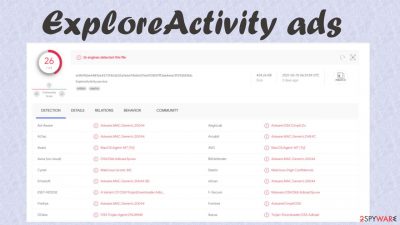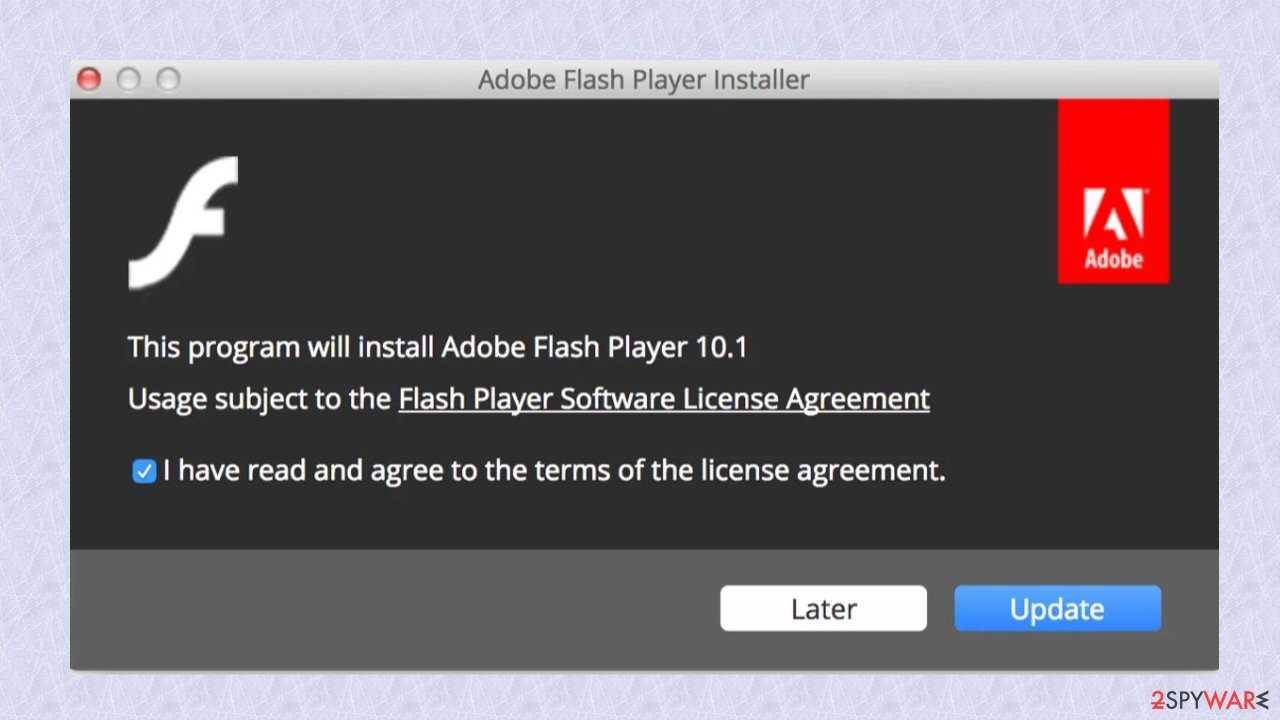ExploreActivity ads (Removal Instructions) - Free Guide
ExploreActivity ads Removal Guide
What is ExploreActivity ads?
ExploreActivity – a Mac virus that hijacks browsers and shows tons of ads

ExploreActivity is a hybrid of adware and a browser hijacker, as it shows deceptive ads and changes specific browser preferences, including the default search engine, new tab, and the homepage. This malicious computer software affects mainly macOS users, but other devices might get infected too. It derives from a well-known Mac malware family called Adload.
ExploreActivity ads can be displayed in many forms, such as pop-ups, banners, in-text hyperlinks, recommended search results, and so on. They usually show imaginary breaking news stories, fake surveys, and other misleading content to lure users into clicking them.
When your browser is hijacked, all your search inquiries are redirected through a sponsored search site that is a fake search engine as it doesn't generate search results. You'll see altered results from Yahoo (although other outcomes could be possible depending on your geolocation).
If you spotted any of these symptoms on your Mac, we're glad you came to us to resolve them. This article explains how this malicious software might have infected your device, what it does to the system, and of course, how to get rid of ExploreActivity PUP once and for all.
| name | ExploreActivity |
|---|---|
| Type | Mac virus, adware, PUP |
| family | Adload virus |
| Symptoms | Slower Mac performance, more than usual ads, sudden redirects to suspicious sites, slower browsing speed |
| Risks | Redirects to questionable sites might lead to infecting your device further, loss of browsing-related or even personal information |
| Distribution | Fake Flash installers, deceptive ads, freeware/software bundles |
| removal | Scan your Mac with compatible professional anti-malware software to eliminate any PUPs, malware, and suspicious files |
| mac fix | Infections can cause abnormal system behavior, such as crashing, freezing, etc. To fix any system-related irregularities, use the FortectIntego system repair tool |
Adware and browser hijackers are usually installed willingly but unknowingly either through deceptive ads, software bundles, fake updaters, and alike. Due to their distribution and mischievous features, they're categorized as potentially unwanted programs (PUPs).
ExploreActivity PUP can endanger macOS users' privacy and security by showing them deceptive ads that could redirect them (if clicked on) to promotional, questionable, or even malicious portals. These websites could try to:
- push to install other PUPs,
- try to draw out private details,
- show explicit content,
- download malware through drive-by downloads,
- lure with various promotions into gambling, gaming, etc.
When you're visiting a site and see ExploreActivity ads, they will be originating from a different source than the page you're visiting. And since PUP operators don't care where their revenue comes from as far as it does, these websites could be malicious.

Furthermore, the ExploreActivity browser hijacker will redirect all searches through a fake search site. That enables it to collect your browsing-related data, including IP addresses, geolocations, search queries, lists of visited sites, etc. This gathered info could be shared with third-parties which intentions might be other than to show you specially tailored ads.
In other words, having the ExploreActivity virus installed on your device is very unsafe. If one PUP is installed, others might soon join them. Therefore, we highly recommend scanning your device with professional anti-malware tools that are compatible with your OS.
Security tools like SpyHunter 5Combo Cleaner or Malwarebytes will automatically locate, isolate, and remove ExploreActivity ads from infected machines. If either of those app's virus databases is constantly updated, it should be able to prevent the latest PUPs and malware from infecting the device.
Infections, whether PUPs or malware, usually make various system modifications. That may lead to system irregularities, including severe lag, freezing, crashing, etc. To repair any system issues that arise with ExploreActivity ads removal, cybersecurity experts at Uirusu.jp[1] highly advise using the FortectIntego system diagnostics tool.
Software bundling and deceiving pop-ups cause most PUP installations
Potentially unwanted program developers use a sneaky technique to distribute their products. When it is referring to Mac malware Flash player updaters, deceiving promotional ads and other online content can be blamed more often than those common p2p sites and torrent services that users often abuse without taking possible risk into consideration.
However, various PUP developers and providers rely on the more common method that allows distributing many apps at once. It's called bundling. Adware, browser hijackers, and PUPs alike are packed with legitimate software or freeware. These bundles can be downloaded from various sources, but most likely from third-party software vendors.

The trick is that all apps on a bundle are automatically preselected for installation. To prevent PUP from entering your device, you'd have to take your time and choose the Advanced/Custom installation method instead of the Recommended/Quick one. And then pick to install the software that you intended to.
A conducted study[2] revealed that 62% of 50 of the most popular installers on one of the most commonly used software vendors had PUPs. Therefore, you should get your desired apps directly from their developers or official distributors to evade PUP infections.
Remove ExploreActivity virus from macOS with anti-malware tools
ExploreActivity ads and redirects will immensely impede your browsing experience. Shown ads can cover the whole browser screen, while redirects can happen out of the blue and redirect you to suspicious sites where various scams will try to deceive you in some way.
Therefore, our cybersecurity team highly recommends our readers to remove ExploreActivity ads from their Mac devices. The most effective way to do that is by scanning your entire device system with a compatible trustworthy anti-malware tool.
The need for a reliable security tool is reiterated in VirusTotal research,[3] which shows that 26 out of 63 AV engines have apprehended this infection. Here are a few samples of its detection names:
- MacOS:Agent-MT [Trj]
- Program:MacOS/Uwamson.A!ml
- OSX.Trojan.Gen
- Adware.MAC.Generic.20044 (B)
- OSX/Dldr.Adload.fpvxw
You might have to get your hands dirty to finish ExploreActivity ads removal, as you could need to reset your browsers. We provide free step-by-step instructions for that just below this paragraph. Once your device is virus-free, perform system diagnostics with powerful system repair tools to ensure stable device performance.
You may remove virus damage with a help of FortectIntego. SpyHunter 5Combo Cleaner and Malwarebytes are recommended to detect potentially unwanted programs and viruses with all their files and registry entries that are related to them.
Getting rid of ExploreActivity ads. Follow these steps
Delete from macOS
Remove items from Applications folder:
- From the menu bar, select Go > Applications.
- In the Applications folder, look for all related entries.
- Click on the app and drag it to Trash (or right-click and pick Move to Trash)

To fully remove an unwanted app, you need to access Application Support, LaunchAgents, and LaunchDaemons folders and delete relevant files:
- Select Go > Go to Folder.
- Enter /Library/Application Support and click Go or press Enter.
- In the Application Support folder, look for any dubious entries and then delete them.
- Now enter /Library/LaunchAgents and /Library/LaunchDaemons folders the same way and terminate all the related .plist files.

Remove from Microsoft Edge
Delete unwanted extensions from MS Edge:
- Select Menu (three horizontal dots at the top-right of the browser window) and pick Extensions.
- From the list, pick the extension and click on the Gear icon.
- Click on Uninstall at the bottom.

Clear cookies and other browser data:
- Click on the Menu (three horizontal dots at the top-right of the browser window) and select Privacy & security.
- Under Clear browsing data, pick Choose what to clear.
- Select everything (apart from passwords, although you might want to include Media licenses as well, if applicable) and click on Clear.

Restore new tab and homepage settings:
- Click the menu icon and choose Settings.
- Then find On startup section.
- Click Disable if you found any suspicious domain.
Reset MS Edge if the above steps did not work:
- Press on Ctrl + Shift + Esc to open Task Manager.
- Click on More details arrow at the bottom of the window.
- Select Details tab.
- Now scroll down and locate every entry with Microsoft Edge name in it. Right-click on each of them and select End Task to stop MS Edge from running.

If this solution failed to help you, you need to use an advanced Edge reset method. Note that you need to backup your data before proceeding.
- Find the following folder on your computer: C:\\Users\\%username%\\AppData\\Local\\Packages\\Microsoft.MicrosoftEdge_8wekyb3d8bbwe.
- Press Ctrl + A on your keyboard to select all folders.
- Right-click on them and pick Delete

- Now right-click on the Start button and pick Windows PowerShell (Admin).
- When the new window opens, copy and paste the following command, and then press Enter:
Get-AppXPackage -AllUsers -Name Microsoft.MicrosoftEdge | Foreach {Add-AppxPackage -DisableDevelopmentMode -Register “$($_.InstallLocation)\\AppXManifest.xml” -Verbose

Instructions for Chromium-based Edge
Delete extensions from MS Edge (Chromium):
- Open Edge and click select Settings > Extensions.
- Delete unwanted extensions by clicking Remove.

Clear cache and site data:
- Click on Menu and go to Settings.
- Select Privacy, search and services.
- Under Clear browsing data, pick Choose what to clear.
- Under Time range, pick All time.
- Select Clear now.

Reset Chromium-based MS Edge:
- Click on Menu and select Settings.
- On the left side, pick Reset settings.
- Select Restore settings to their default values.
- Confirm with Reset.

Remove from Mozilla Firefox (FF)
Remove dangerous extensions:
- Open Mozilla Firefox browser and click on the Menu (three horizontal lines at the top-right of the window).
- Select Add-ons.
- In here, select unwanted plugin and click Remove.

Reset the homepage:
- Click three horizontal lines at the top right corner to open the menu.
- Choose Options.
- Under Home options, enter your preferred site that will open every time you newly open the Mozilla Firefox.
Clear cookies and site data:
- Click Menu and pick Settings.
- Go to Privacy & Security section.
- Scroll down to locate Cookies and Site Data.
- Click on Clear Data…
- Select Cookies and Site Data, as well as Cached Web Content and press Clear.

Reset Mozilla Firefox
If clearing the browser as explained above did not help, reset Mozilla Firefox:
- Open Mozilla Firefox browser and click the Menu.
- Go to Help and then choose Troubleshooting Information.

- Under Give Firefox a tune up section, click on Refresh Firefox…
- Once the pop-up shows up, confirm the action by pressing on Refresh Firefox.

Remove from Google Chrome
Delete malicious extensions from Google Chrome:
- Open Google Chrome, click on the Menu (three vertical dots at the top-right corner) and select More tools > Extensions.
- In the newly opened window, you will see all the installed extensions. Uninstall all the suspicious plugins that might be related to the unwanted program by clicking Remove.

Clear cache and web data from Chrome:
- Click on Menu and pick Settings.
- Under Privacy and security, select Clear browsing data.
- Select Browsing history, Cookies and other site data, as well as Cached images and files.
- Click Clear data.

Change your homepage:
- Click menu and choose Settings.
- Look for a suspicious site in the On startup section.
- Click on Open a specific or set of pages and click on three dots to find the Remove option.
Reset Google Chrome:
If the previous methods did not help you, reset Google Chrome to eliminate all the unwanted components:
- Click on Menu and select Settings.
- In the Settings, scroll down and click Advanced.
- Scroll down and locate Reset and clean up section.
- Now click Restore settings to their original defaults.
- Confirm with Reset settings.

Delete from Safari
Remove unwanted extensions from Safari:
- Click Safari > Preferences…
- In the new window, pick Extensions.
- Select the unwanted extension and select Uninstall.

Clear cookies and other website data from Safari:
- Click Safari > Clear History…
- From the drop-down menu under Clear, pick all history.
- Confirm with Clear History.

Reset Safari if the above-mentioned steps did not help you:
- Click Safari > Preferences…
- Go to Advanced tab.
- Tick the Show Develop menu in menu bar.
- From the menu bar, click Develop, and then select Empty Caches.

After uninstalling this potentially unwanted program (PUP) and fixing each of your web browsers, we recommend you to scan your PC system with a reputable anti-spyware. This will help you to get rid of ExploreActivity registry traces and will also identify related parasites or possible malware infections on your computer. For that you can use our top-rated malware remover: FortectIntego, SpyHunter 5Combo Cleaner or Malwarebytes.
How to prevent from getting browser hijacker
Choose a proper web browser and improve your safety with a VPN tool
Online spying has got momentum in recent years and people are getting more and more interested in how to protect their privacy online. One of the basic means to add a layer of security – choose the most private and secure web browser. Although web browsers can't grant full privacy protection and security, some of them are much better at sandboxing, HTTPS upgrading, active content blocking, tracking blocking, phishing protection, and similar privacy-oriented features. However, if you want true anonymity, we suggest you employ a powerful Private Internet Access VPN – it can encrypt all the traffic that comes and goes out of your computer, preventing tracking completely.
Lost your files? Use data recovery software
While some files located on any computer are replaceable or useless, others can be extremely valuable. Family photos, work documents, school projects – these are types of files that we don't want to lose. Unfortunately, there are many ways how unexpected data loss can occur: power cuts, Blue Screen of Death errors, hardware failures, crypto-malware attack, or even accidental deletion.
To ensure that all the files remain intact, you should prepare regular data backups. You can choose cloud-based or physical copies you could restore from later in case of a disaster. If your backups were lost as well or you never bothered to prepare any, Data Recovery Pro can be your only hope to retrieve your invaluable files.
- ^ Uirusu. Uirusu. Spyware and security news.
- ^ Slade. 62% of the Top 50 Download.com applications bundle toolbars and other PUPs. Emisoft. Security blog.
- ^ VirusTotal. Virustotal. Suspicious file analysis platform.




















